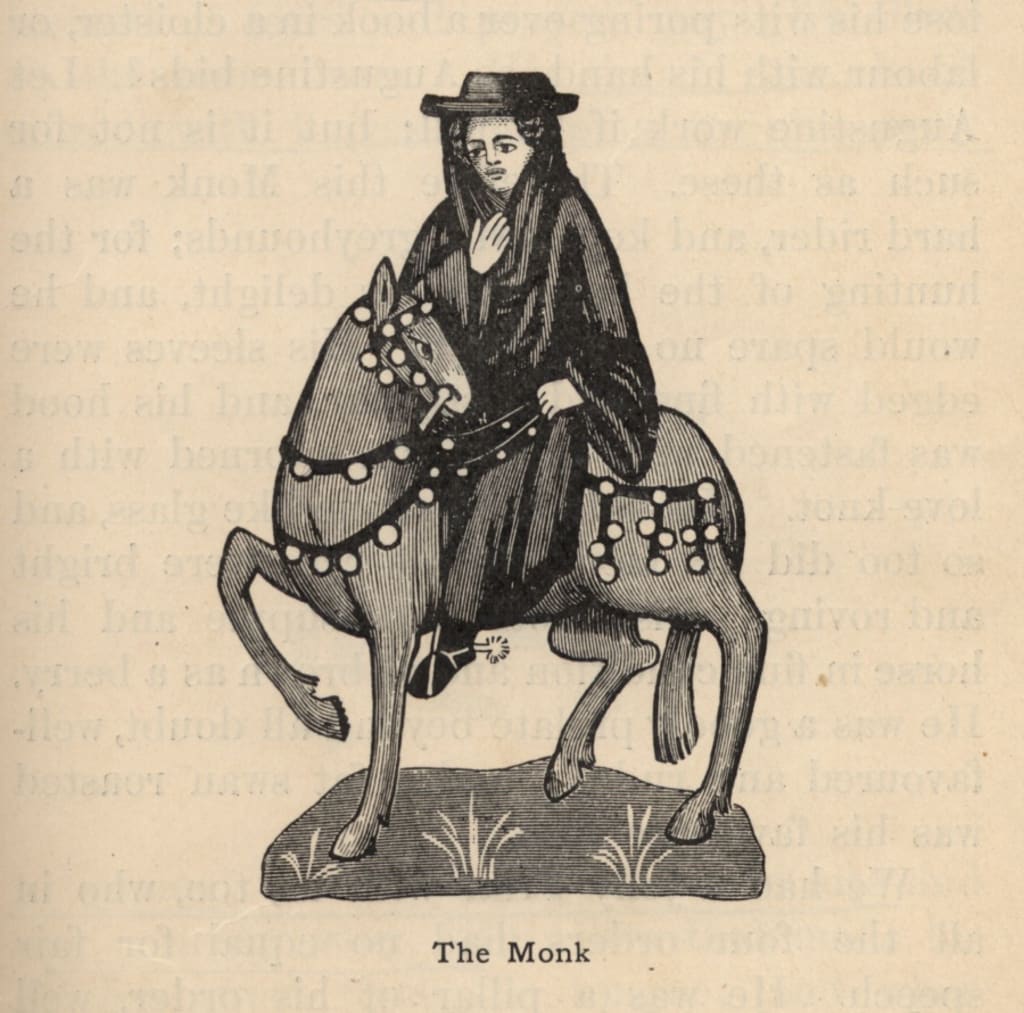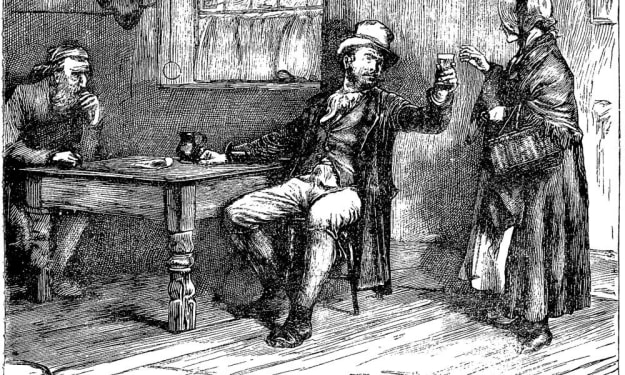The Monk's Tale, by Geoffrey Chaucer
The pilgrim is interrupted before he can mention any more tragic characters

The Monk’s Tale is unusual among Chaucer’s Canterbury Tales in several respects. For one thing, it is interrupted by another pilgrim before it can be completed, something it shares with Chaucer’s own Tale of Sir Thopas, which had been told not long before.
Secondly, the Tale uses a metrical form that is not used for any of the other Tales, although it occurs in some other works by Chaucer. This is an eight-line stanza with the rhyme scheme ABABBCBC.
Thirdly, it is not a single tale at all, but a succession of seventeen stories, of varying length, which all purport to say the same thing, namely “how are the mighty fallen”.
The background of the Monk’s Tale is the aftermath of Chaucer’s own Tale of Melibee. This had been Chaucer’s second tale, after the Host cut off his Tale of Sir Thopas and Chaucer offered “a little thing in prose” that turned out to be an immensely long tale that, to modern taste, is virtually unreadable, consisting largely of a philosophical discourse on the themes of revenge and forgiveness. However, this is to misunderstand 14th century likings and attitudes, and the pilgrims have clearly been listening intently, not least the Host.
The first 35 lines of the Monk’s prologue do not mention the Monk at all, being the Host’s response to Chaucer. The Host has been impressed by the attitude and example of Prudence, the wife of Melibee, and he wishes that his own wife had the same character. Instead, she is all for violence being visited on any wrongdoer, and the Host fears that one day she will be the cause of him committing a murder. She would appear to be a literary precursor of Lady Macbeth!
The Host then turns to the Monk, and begins by praising and admiring him. From the account of the Monk given in the General Prologue we know that this man is very far from the image one should have of a humble, religious man, sworn to poverty and simple living. This monk loves luxury above all else, reckons that the rules of his Order are there to be broken, and spends most of his time hunting, hawking, feasting and generally enjoying himself. It was people like him who contributed to giving religious orders a bad name in the 14th century.
However, the Host speaks without irony when he addresses the Monk as being “a governor, wily and wise” and “a well-conditioned person”. He regrets that the Monk should ever have entered the religious life, as such a worthy man should be married and breeding more of the same! Perhaps there is a touch of irony, though, when he points out that non-religious people produce such feeble offspring and women always seem to have an eye for a handsome man of religion.
The Monk does not reply to any of this, other than to agree to tell a tale. He could, he tells the pilgrims, give them the life of Saint Edward (the Confessor, presumably). However, his preference is to tell tragic tales, in which people of great prosperity and high degree are brought low. He knows a hundred such stories. This seems to be oddly out of character, but it is not remarked upon. Another oddity is the Monk’s pedantic description of the verse form normally used for the telling of such stories. We can imagine the face of the Host falling fast as the Monk’s response to his personal remarks takes a very different turn to what he had expected.
The Tale
So begin the seventeen short stories, some of them comprising a single stanza, which do little more than say that the subject fell from grace, and others being somewhat longer, the longest stretching to 16 stanzas. The subjects are from ancient and more recent history, mythology, and the Old Testament. To take them in turn:
Lucifer. One stanza
Adam. One stanza
Samson. Ten stanzas that relate the story from the Book of Judges of the strong man brought low by the wiles of Delilah, who cut his hair and thus deprived him of his strength. The Monk warns men against telling their wives too much.
Hercules. Six stanzas that mention the labours of Hercules then recount the story from Ovid of the poisoned shirt unwittingly given to him by Dianira, his mistress. This causes his death, although the Monk does not mention that Hercules was half-immortal, so only the mortal half of him could die.
Nebuchadnezzar. Five stanzas based on the account in the Book of Daniel of the madness of the king of Babylon.
Belshazzar. Eight stanzas telling of the downfall of the son of Nebuchadnezzar, who feasted out of vessels taken from the Temple at Jerusalem and literally saw the writing on the wall that foretold his doom.
Zenobia. Sixteen stanzas are devoted to the only woman in the Monk’s catalogue, making this the longest of the mini-tales. Zenobia was a warrior queen of Palmyra in the 3rd century A.D. The Monk tells how she married reluctantly and would only allow her husband sex for the purpose of procreation. She became empress when her husband died, and conquered many lands before losing to the Roman Empire under Aurelian and being paraded in chains.
Peter, King of Spain. Two stanzas about “Peter the Cruel” who ruled Castile from 1350 to 1369. Although regarded in some quarters as a tyrant, the Monk is sympathetic to this man, who was betrayed and murdered by his usurping brother. It is known that Chaucer had visited Castile while Peter was still king.
Peter, King of Cyprus. One stanza about a crusading king who captured Alexandria but was assassinated by envious subjects.
Bernabo Visconti of Lombardy. One stanza about a near-contemporary event, which was probably inserted in the Canterbury Tales at a much later date than the rest. Bernabo died in 1385, murdered by his nephew.
Ugolino of Pisa. Seven stanzas that dwell more on the legend surrounding Ugolino than the actual facts. According to the Monk, Ugolino was unjustly overthrown and imprisoned, together with his three young children, and starved to death. After the youngest child dies, Ugolino gnaws at his own arms in anguish and the surviving children, thinking that he is doing so out of hunger, urge him to eat them when they are dead. The Monk ends by saying that, if you want to know more, you should read Dante’s account.
Nero. Eleven stanzas on the downfall of a notorious Roman emperor. His viciousness and cruelties are described with some degree of relish, until Fortune’s wheel turns and he is forced to kill himself or suffer worse from the mob.
Holofernes. Three stanzas on a story from the Old Testament Apocrypha. He was a general sent by Nebuchadnezzar to subdue the city of Bethulia, but was seduced by Judith, a Jewish woman who made him drunk and then beheaded him as he slept.
Antiochus. Seven stanzas. This is another story from the Apocrypha, namely the Book of Maccabees. His campaign against the Jews is thwarted when he suffers from a painful disease and injuries incurred by a fall. He is then eaten alive by maggots.
Alexander the Great. Five stanzas that tell of his conquests and power, but “poisoned of thine own folk thou were”. However, that is all the detail we are told of his demise.
Julius Caesar. Seven stanzas. This is the classical story of his murder, although with no mention of the Ides of March. The Monk is careful to tell us that the dying Caesar took care to cover himself and preserve his personal decency. We get two downfalls for price of the one, because the death of Pompey is also included.
Croesus. Five stanzas about a figure who was partly historical and partly mythological. He is condemned by Cyrus of Persia to be burned alive, but a rainstorm douses the flames and he escapes. He has a vision that he is in a tree, where he is attended by Jupiter and Phoebus. He asks his daughter to interpret the vision, and she tells him that he will be hanged, which is what does indeed happen.
And at this point the Knight intervenes to say that he has had quite enough. He would rather hear stories about people who have risen from misfortune to prosperity. The host agrees, and calls on the Monk to tell them something that is a bit more cheerful, a story about hunting, perhaps. However, the Monk refuses, and suggests that it is someone else’s turn.
Discussion
So what can we make of the Monk’s efforts? One point worth making is that Fortune is named as playing a part in the downfall of all but three of the people mentioned by the Monk (the exceptions are Adam, Samson and Bernabo Visconti). There is therefore a consistent theme running throughout these mini-tales, namely that it is the turning of the wheel of Fortune that brings great people down, with the implication that they cannot be held to blame for their misfortunes, or at least only in part.
In other words, the Monk’s (and Chaucer’s) definition of “tragedy” is different from that of writers such as Shakespeare, who see tragedy as ensuing from the actions of the victim, who makes a wrong choice and cannot escape from its consequences.
Nobody has ever regarded the Monk’s Tale as being among the best of the Canterbury Tales, and it is difficult to work out what Chaucer hoped to achieve by writing a tale of this nature. There is some variety here, in the sweep through mythology, the Bible and history, some macabre touches, and a touchingly sentimental piece in the story of Ugolino, but the whole thing is too disjointed to be successful as a Tale and, overall, the Monk’s Tale is a disappointment.
About the Creator
John Welford
I am a retired librarian, having spent most of my career in academic and industrial libraries.
I write on a number of subjects and also write stories as a member of the "Hinckley Scribblers".






Comments
There are no comments for this story
Be the first to respond and start the conversation.